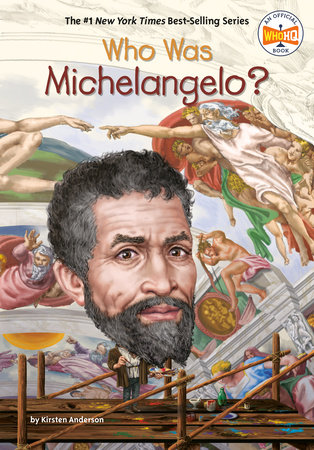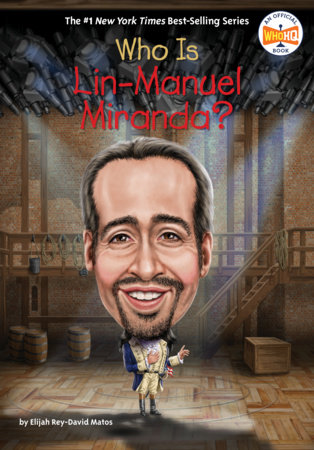Excerpt
Who Was Michelangelo?
Who Was Michelangelo? A crowd gathered around the new statue in the chapel of Santa Petronilla in 1500. It was indeed a wonder. The sculpture showed a famous scene from the Bible. There was the Virgin Mary, holding the body of her dead son, Jesus Christ. This scene is often called a pietà
. (
Pietà means “pity” in Italian.) Many others had painted or sculpted this same grouping of mother and son. But this statue was different. Although carved from hard marble, it was incredibly lifelike. People could see tiny details, like stretched muscles and the pull of the skin where Mary’s hand held onto the body of Jesus. The folds of Mary’s gown looked as soft as real fabric. When the sun streamed through the chapel’s windows, the statue glowed. It was hard to believe it was carved from stone.
Everyone agreed that it was a magnificent work, unlike anything they had seen before. But who had carved it? Many of the people gathered in the chapel that day didn’t seem to know. As much as the crowd loved the image before them, they might not have been looking
too closely at it.
Nearby, a young man listened quietly. He was amazed that anyone would wonder who the artist was.
He had made the statue. Hadn’t they seen his name? On a ribbon across Mary’s chest, he had carved the words, “Michelangelo the Florentine was making.” He wrote “was making” instead of “made” because he had heard that the artists of ancient Greece signed their work like that. It was their way of saying that a work of art was never truly finished.
But Michelangelo (say: mee-keh-LAN-juh-low) was ready to begin working on something new. He had other important projects ahead of him. Soon he would become known as one of the greatest artists in the world. Hundreds of years later, people are still awed by the statues, paintings, and buildings he made.
And he never signed any others. That first pietà is the only one with his name on it. After that, no one would look at his work and ask, “Who made this?” Everyone would know it was Michelangelo.
Chapter 1: Education of an Artist Michelangelo di Lodovico Buonarroti Simoni was born on March 6, 1475, in Caprese, a town in what is now known as Italy. His family was really from Florence, a big city nearby, but his father, Lodovico, had taken a job as
podesta, or mayor, of Caprese for a year. Then the Buonarrotis, as they were known, returned to Florence.
Michelangelo had one older brother and three younger brothers. His mother, Francesca, died when he was six. The Buonarrotis had once been a wealthy merchant family, but by the late 1400s, they had lost almost all of their large fortune. Lodovico, though, considered himself a member of the upper class and believed it was beneath him to work. He occasionally took small government jobs, and the family tried to get by on the money he earned from those.
Lodovico thought that Michelangelo seemed clever and decided to send him to school, which was not common at that time. However, Michelangelo became interested in art at an early age, and he spent more time sketching than studying. His father was angry. He didn’t want his son to be an artist. He considered artists to be unskilled workers. Lodovico and Michelangelo’s brothers often beat him when they caught him drawing.
Michelangelo became friends with Francesco Granacci, an apprentice in the workshop of Domenico Ghirlandaio, one of Florence’s best-known painters. An apprentice is taught a particular craft by someone who is a master at it, in exchange for the work they do. Granacci introduced Michelangelo to Ghirlandaio, who invited him to become one of his apprentices. Lodovico still didn’t like the idea of his son becoming an artist, but he realized that he couldn’t stop him. In 1488, when he was thirteen, Michelangelo joined Ghirlandaio’s workshop.
Working with Ghirlandaio, Michelangelo studied the basics of painting, such as how to mix colors and prepare a canvas. Ghirlandaio was working on a series of frescoes at the time. A fresco is a large-scale painting, usually done on a wall or ceiling, that is created by a specific technique using plaster. Michelangelo probably learned how to work in this medium from Ghirlandaio. Later in life, Michelangelo would say that Ghirlandaio hadn’t taught him anything. He even claimed that he had never been Ghirlandaio’s apprentice! He wanted people to think that he had learned everything on his own.
But Ghirlandaio had been helpful to Michelangelo. He introduced him to someone important—someone who would change his life.
Lorenzo de’ Medici was the most powerful man in Florence. He loved art, literature, and music. Lorenzo, known as “Lorenzo the Magnificent,” knew that Florence had many painters but not many sculptors. In 1490, he asked Ghirlandaio to send over a few apprentices who might be interested in learning to sculpt statues from marble. Lorenzo had a garden filled with antique sculptures for young artists to study, and his staff included Bertoldo di Giovanni, who had been trained by Donatello, the last great sculptor from Florence. Ghirlandaio sent both Francesco Granacci and Michelangelo to Lorenzo.
Michelangelo immediately became fascinated with the art of sculpting and began to visit the Medici garden as often as he could. He made copies of some of the pieces he saw there. Lorenzo the Magnificent was impressed by Michelangelo’s work and asked to speak with Lodovico about Michelangelo’s future. He wanted the young artist to move into the Medici palace and study sculpture full-time.
But Lodovico didn’t want his son to become a sculptor. He thought a sculptor was no better than a simple stonecutter. It would disgrace the family for Michelangelo to make his living that way. Lodovico couldn’t ignore a request from a Medici, though, and he finally went to meet him.
Lorenzo said that he would treat Michelangelo like a son and help him become a great artist. In exchange, he offered Lodovico any job he wanted in Florence. Lodovico only asked for a low-level clerk’s job. He still didn’t believe a Buonarroti should have to work.
Michelangelo was embarrassed that his father did not choose a more important job. Lodovico had missed a great opportunity. Michelangelo was different from his father. He wanted to be important. And he never wanted to miss a great opportunity.
Chapter 2: Renaissance Man During Michelangelo’s lifetime, Florence was a center of artistic growth and achievement. At Lorenzo the Magnificent’s house, Michelangelo listened to philosophers and writers talk, and he mingled with other artists. This period of artistic and scientific importance is known as the Renaissance. Life at the Medici home opened up a whole new world for Michelangelo.
In 1492, Lorenzo de’ Medici died. Michelangelo returned to his father’s house. Soon after that, he was offered a chance to carve a wooden crucifix for a church called Santo Spirito. The church also had a hospital where they treated poor people. Michelangelo wanted to learn more about the human body.
He asked the hospital if he could dissect, or cut open to examine, bodies that weren’t claimed by family members of patients who had died, and they agreed. Now he was able to study how muscles connected to one another and how they looked when they were stretched, tightened, or twisted when in motion. Michelangelo used this valuable knowledge to make his sketches and sculptures more realistic.
Florence was supposed to be a republic, a city run by the people. But for decades it had really been ruled by the Medici family. In 1494, the people of Florence rose up against Piero de’ Medici, Lorenzo’s son. Michelangelo left Florence and went to the city of Bologna. For the next year, he stayed with a nobleman there and sculpted a few small pieces for a local church. When he heard that the Medici family had fled Florence, Michelangelo decided it was safe to return home.
Once back in Florence, he did some work for Lorenzo di Pierfrancesco de’ Medici, a less-important member of the Medici family. One sculpture was of a sleeping Cupid, based on an ancient statue he had seen in Lorenzo the Magnificent’s garden. Lorenzo di Pierfrancesco suggested that if Michelangelo made it look like an older statue, they would be able to pass it off as an antique and sell it for more money in Rome. They buried the statue to make it look dirtier and older, and then sold it for a high price to a Catholic church official named Cardinal Riario in Rome. When Riario heard whispers that his statue was actually a new sculpture from Florence, he became angry. He sent an employee to Florence to find the artist who had made it. Riario wanted proof that the statue was not an antique so he could get his money back. But he also had been impressed by the statue and hoped to bring the talented artist back to Rome to work for him!
Riario’s employee searched all over Florence for the mysterious artist. Finally, he arrived at Michelangelo’s house and pretended he wanted to have a sculpture made for himself. He asked the young artist if he could see some work. According to Michelangelo, he did not have any sculptures in his workshop at the moment, so he offered to sketch the man’s hand. The man from Rome looked at the drawing and was convinced that he had found the right artist. Michelangelo admitted that he had made the Cupid statue. When the man invited him to come to Rome, he agreed. Rome was an important city, and Michelangelo knew he would have the opportunity to make his name there.
In Rome, Cardinal Riario gave the young sculptor a block of marble and asked him to carve something from it. Michelangelo spent a year sculpting a statue of the Greek god Bacchus, but Cardinal Riario didn’t like it. In the end, it was sold to one of the cardinal’s business associates.
Michelangelo looked for more work from the wealthy citizens of Rome, and in 1497, he got his big break. A French cardinal offered him a commission to carve a pietà
—a statue of the Blessed Mother and her son, Jesus. A commission is a formal request to produce something, like an order for a piece of art. The patron, or buyer, tells the artist what to make. They sign a contract that states how much the artist will be paid, how long it will take to create, and what materials or other expenses the patron agrees to pay for. Michelangelo’s commission even promised that the statue would be “more beautiful than any work in marble to be seen in Rome today.” He was that confident.
But his confidence was based on his very real talent. When Michelangelo finished the
Pietà in 1500, people were amazed. The sculpture was almost six and a half feet tall and six feet wide. Michelangelo had put his knowledge of the human body to work. The body of Christ looked very real. Mary’s face reveals deep sadness. Michelangelo had discovered that he could create soft emotion from the hard marble.
Michelangelo was just twenty-five years old. But he had already made one of the most famous works of art in history.














